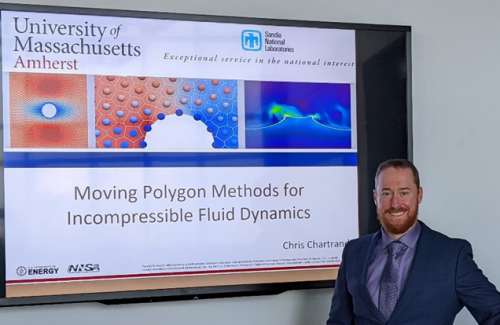
Sandia Water Power program researcher Chris Chartrand recently completed his PhD in Mechanical Engineering thanks to educational opportunities offered through Sandia National Laboratories’ University Education Programs. Sandia offers these benefits to build the professional capabilities of the Laboratories’ employees and designs individual programs to support special technical talent acquisition, workforce diversity, and critical skills development.
Chris started his career at Sandia in 2014 when he joined the Water Power program as a limited-term employee. There, he led the development of SNL-SWAN (Simulating WAves Nearshore) and SNL-Delft3D, two mid-fidelity numerical codes for modeling the hydrodynamic effects of wave energy converter (WEC) and current energy conversion (CEC) devices on ocean and river environments.
In June of 2015, Chris transitioned to a full-time, regular employee for the Water Power program and began to take advantage of Sandia’s Tuition Assistance Program, attending evening classes at the University of New Mexico and completing all of his classroom credit requirements for his PhD. In September of 2017, Chris applied for and was accepted into Sandia’s competitive Critical Skills Part-Time Program, formerly known as the Special Degree Program, which supports Sandia in building future capabilities in defined critical-skill-need areas.
“The application process took time, and there were a number of requirements I had to meet,” Chris said. “There were letters of recommendation from my Sandia manager and the vice president of my Center [Jim Chavez at the time] that had to be written, as well as a formal proposal addressed to the Special Degree Program committee [today the Critical Skills Part-Time Program committee].”
Chris studied predictive simulation and numerical modeling through the University of Massachusetts Amherst, performing research for his PhD at half time over a two-year period, while continuing to work on the Water Power program’s coastal resource assessment project and the WEC, CEC, and Acoustics modeling projects.
He described the experience as much like independent study. “My UMASS advisor, Blair Perot, was very active in helping guide my efforts,” Chris said. “I kept in touch with him through video calls, while I performed my research remotely at Sandia.”
Chris returned to full-time work in the Water Power program in 2019, supporting the multi-lab Wave-SPARC (Systematic Process and Analysis for Reaching Commercialization) project, acting as the simulation Lead on a California Energy Commission project focused on atmospheric modeling in partnership with Integral Consulting, managing multiple TEAMER (Testing Expertise and Access to Marine Energy Research) projects, and acting as a subject matter expert for the Defense Advanced Research Projects Agency.
Thanks to Sandia’s educational assistance programs, Chris successfully defended his thesis, “Moving Polygon Methods for Incompressible Fluid Dynamics,” in December of 2021, describing his work to develop a new, moving mesh approach to simulating material discontinuities like the air–water interface of crashing wave ocean environments.
Chris is the author of, or contributor to, several peer-reviewed journals, conference papers and presentations, and he is a member of Phi Beta Kappa. Over the years that he’s worked at Sandia, he’s developed and maintained software, designed complex computational fluid dynamics models, performed high-fidelity numerical analysis, and mentored junior staff members, where he assisted new hires and interns to navigate the learning curve of simulation and high-performance computing.
Looking back, Chris is thankful for the experience. “It’s a difficult process, but it’s a great opportunity if you’re willing to put in the time and effort,” he said.
Read more about Sandia’s University Education Programs and eligibility requirements.
Learn more about Sandia’s Water Power program.
April 13, 2022